Kitchen Countertops
When replacing kitchen countertops, clients are often surprised by what’s involved. Apparently, many contractors do not inform the client what the process is. Typically, contractors focus strictly on the kitchen countertops, ignoring all the other critical pieces. Why? Because they want the kitchen countertop business! Clients who have had kitchen countertops replaced complain of expensive change orders and lots of unplanned and shoddy work.
What you need to know about kitchen countertop installation.
Most importantly, you will be performing a lot more work than just kitchen countertops. Take a few moments and go look at your kitchen. Stand outside of your kitchen and spend a few moments looking closely at it. Got that picture? Awesome – here we go!
Here are all the other pieces when replacing your kitchen countertops. Whoever is installing the kitchen countertops, make sure they perform all of the items below. Don’t get bamboozled! Find a reputable contractor who will provide a detailed by line item estimate to perform the entire job – correctly and safely! Only licensed contractors can replace kitchen countertops.
Kitchen countertops and the backsplash.
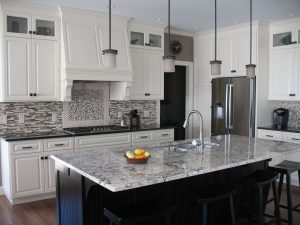 Granite and quartz countertops are attached to the top of the cabinets using glue. Tile countertops are installed over a bed of mortar. This mortar is installed over metal lath that is stapled to the top of the cabinets. Cabinets in tract homes are incredibly cheap. Cabinets purchased from home improvement stores and those advertising in magazines and mailers are just as bad. To some degree, the cabinets always receive some damage during countertop removal. About half the time they are damaged beyond repair. What does this mean? You get an expensive change order for repairs or new cabinets. Typically, the demolition crew will say nothing, and the new kitchen countertops are installed over the damaged cabinets. These can collapse, causing serious injury, especially to small children.
Granite and quartz countertops are attached to the top of the cabinets using glue. Tile countertops are installed over a bed of mortar. This mortar is installed over metal lath that is stapled to the top of the cabinets. Cabinets in tract homes are incredibly cheap. Cabinets purchased from home improvement stores and those advertising in magazines and mailers are just as bad. To some degree, the cabinets always receive some damage during countertop removal. About half the time they are damaged beyond repair. What does this mean? You get an expensive change order for repairs or new cabinets. Typically, the demolition crew will say nothing, and the new kitchen countertops are installed over the damaged cabinets. These can collapse, causing serious injury, especially to small children. The old countertops and backsplash must be removed. Typically, the backsplash is installed directly over the drywall. When the old backsplash is removed, it destroys the drywall. Every kitchen backsplash has (or should have) a drywall backsplash regardless of what is installed over it. This drywall must be replaced prior to installing the new kitchen countertop. Installing a new backsplash over damaged drywall is a huge mistake. The new splash will likely crack, come loose, fall off, and allow water to enter – causing serious mold, mildew, and rot damage.
The old countertops and backsplash must be removed. Typically, the backsplash is installed directly over the drywall. When the old backsplash is removed, it destroys the drywall. Every kitchen backsplash has (or should have) a drywall backsplash regardless of what is installed over it. This drywall must be replaced prior to installing the new kitchen countertop. Installing a new backsplash over damaged drywall is a huge mistake. The new splash will likely crack, come loose, fall off, and allow water to enter – causing serious mold, mildew, and rot damage.- If you have a Type X (firewall) drywall backsplash, not replacing it opens you up to tremendous liability. It also subjects you, your family, neighbors, and community to potentially serious life-threatening fire and safety risks!
What other things do I need to know when the kitchen countertops are removed?
 If you do not completely empty the contents of all drawers and cabinets, everything inside gets really dirty. All drawers and insides of cabinets will need a thorough cleaning after demolition and again after installation. Pay special attention to the drawer glides and door hinges. Dust and debris during demolition can destroy or seriously damaged these items.
If you do not completely empty the contents of all drawers and cabinets, everything inside gets really dirty. All drawers and insides of cabinets will need a thorough cleaning after demolition and again after installation. Pay special attention to the drawer glides and door hinges. Dust and debris during demolition can destroy or seriously damaged these items.- All the receptacles (outlets), switches, dimmers, cable, telephone, smart plugs, and charging ports should be replaced. Here too, the electrical appliances installed by the original builder were very low quality. Building code now requires all kitchen countertop outlets be no more than 4 feet apart. If yours are more than this, you will need to add more. Moreover, they must now be on an AFCI/GFCI circuit for your safety and protection.
- Before removing the existing backsplash, all undercabinet lights will need to be removed. If these are not LED, replace.
- If you have a tile countertop and you are replacing with granite or quartz, you will need to resolve the cabinet face-front color or fade areas where the tile extended down. The edge detail from the granite or quartz will not cover the areas previously covered by the tile.
Why is there so much electrical work?
 If your home is more than 3 years old, all of these items will require replacement. Why? The electrical and building codes have changed and tract housing electrical appliances typically have a 5 year or less safe and useful life. The term “appliances” refers to receptacles, switches, dimmers, smart plugs, and charging ports.
If your home is more than 3 years old, all of these items will require replacement. Why? The electrical and building codes have changed and tract housing electrical appliances typically have a 5 year or less safe and useful life. The term “appliances” refers to receptacles, switches, dimmers, smart plugs, and charging ports.- Most homes have a backsplash with granite, quartz, tile, stone, or glass. Prior to removing the kitchen countertops, the
 existing backsplash must be removed along with the electrical appliances in the backsplash. After installing the new backsplash, replace with new appliances. It makes little sense to reuse the old, worn out and unsafe appliances.
existing backsplash must be removed along with the electrical appliances in the backsplash. After installing the new backsplash, replace with new appliances. It makes little sense to reuse the old, worn out and unsafe appliances. - Will you be installing a backsplash that extends from the top of the countertop to the bottom of the upper cabinets? If you are, all the receptacles and switches must be moved out. Why? For electrocution and fire safety reasons, you cannot have the wires simply pulled through the new backsplash. Doing this means live electrical wires will be outside the electrical box (obviously not a good idea). Unfortunately, I see this all the time. Why? Because the person who installed the new kitchen countertops and splash tried to make the job as cheap as possible so you would hire them. Very bad idea.
When replacing the kitchen countertops, you will need to remove the appliances and fixtures.
 The microwave (or hood), dishwasher, range (or cooktop), and usually the refrigerator must be removed. When reinstalling the range or cooktop, install a new gas valve and connector. Also ensure the refrigerator gets a new ice maker water supply line. It might also need a new angle stop.
The microwave (or hood), dishwasher, range (or cooktop), and usually the refrigerator must be removed. When reinstalling the range or cooktop, install a new gas valve and connector. Also ensure the refrigerator gets a new ice maker water supply line. It might also need a new angle stop.- You will need to remove the sink, faucet, dishwasher air cap, and soap dispenser. These will all likely require replacing. This includes new angle stops and dishwasher water supply line. The sink will also need a new strainer.
- The garbage disposal, p-trap, and all sewer drain pipes along with the water supply lines will need to be removed
 and replaced with new.
and replaced with new. - Do you have a water filtration or hot water system under the sink? The service provider is responsible for removing and replacing these items. Why can’t the contractor simply remove and reinstall these items? Especially in the case of under sink water filtration systems, the manufacturer typically owns these (you lease them). If an unauthorized representative disconnects or reconnects and the unit is damaged, the warranty is void and you’ll be charged the full replacement.
Is there anything else I should know about replacing my kitchen countertops?
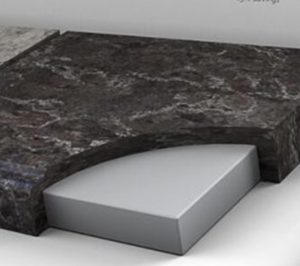 There is a very disturbing trend taking place to save money on new kitchen countertops. What is this great idea? Installing the new countertops over the old countertops (overlays). There are various names for countertop overlays. These include granite counter units (GCUs), modular granite, or modular quartz. The most popular is Caesarstone® Transform. The countertop overlay thickness is about 13 mm (1/2 inch). Overlays will save around 50% on the cost of new countertops. The average cost (materials and labor) for an overlay is about $70-$100 per square foot. Only authorized dealers and installers can install Transform. Under counter and farmhouse (apron) style sinks remain in place. These overlays have the following consequences:
There is a very disturbing trend taking place to save money on new kitchen countertops. What is this great idea? Installing the new countertops over the old countertops (overlays). There are various names for countertop overlays. These include granite counter units (GCUs), modular granite, or modular quartz. The most popular is Caesarstone® Transform. The countertop overlay thickness is about 13 mm (1/2 inch). Overlays will save around 50% on the cost of new countertops. The average cost (materials and labor) for an overlay is about $70-$100 per square foot. Only authorized dealers and installers can install Transform. Under counter and farmhouse (apron) style sinks remain in place. These overlays have the following consequences:
- Countertop overlays will trap bacteria, mildew, moisture, and food residue underneath. These trapped items generate unhealthful pathogens that release into the air.
 Overlays must have seams. Why? Large sections of ½ inch material will break during fabrication, transportation, and installation. Some seams may be more visible.
Overlays must have seams. Why? Large sections of ½ inch material will break during fabrication, transportation, and installation. Some seams may be more visible.- Countertop overlays are only as good as the underlying countertop base. Never install an overlay over a weak or damaged base.
- Does not work well on uneven surfaces. If the existing surface is not perfectly level, overlays will crack. To get around this, installers will use adhesive type fillers. These eventually fail and the overlays crack. Moreover, if you place any weight on them (heavy cooking items, kneel on the counter to wash windows, etc.) overlays will crack.
When replacing my kitchen countertops, do I need permits from my local Building Department?
 Yes, absolutely. You are performing electrical, plumbing, and perhaps fire wall work. You want to make sure it is correct. If you do not acquire all the necessary permits and inspections and something goes wrong, you will likely be financially responsible. Same thing applies if you do not hire a properly licensed and insured contractor. See How Do I Choose a Contractor?
Yes, absolutely. You are performing electrical, plumbing, and perhaps fire wall work. You want to make sure it is correct. If you do not acquire all the necessary permits and inspections and something goes wrong, you will likely be financially responsible. Same thing applies if you do not hire a properly licensed and insured contractor. See How Do I Choose a Contractor?
The contractor is responsible for obtaining all permits when replacing kitchen countertops. Moreover, the contractor is also responsible for scheduling all inspections and being physically present for these inspections.
Always Hire a Reliable and Dependable Contractor to Remodel your Kitchen
 Always work with a trustworthy contractor like DAD’s Construction. We are experts in kitchen remodeling who can manage projects in an efficient manner. DAD’s Construction will do everything to minimize the possibility of change orders. Our team will make sure we have all the necessary information to prepare proposals that meet your requirements. Rest assured that we will provide you with a detailed, by line-item contract. We will make sure that the contents of this agreement are properly and clearly communicated to you. If you have questions or need updates regarding your project, we will always answer your inquiries.
Always work with a trustworthy contractor like DAD’s Construction. We are experts in kitchen remodeling who can manage projects in an efficient manner. DAD’s Construction will do everything to minimize the possibility of change orders. Our team will make sure we have all the necessary information to prepare proposals that meet your requirements. Rest assured that we will provide you with a detailed, by line-item contract. We will make sure that the contents of this agreement are properly and clearly communicated to you. If you have questions or need updates regarding your project, we will always answer your inquiries.
How Can I Receive More Information?
If you would like more information on enjoying the best bathroom, kitchen, and interior remodeling experience in Orange County, call Dan at (949) 380-0177 or at dan@dadsconstruction.com for a free in home consultation. DAD’s serves all of South Orange County California. This includes Lake Forest, Mission Viejo, Foothill Ranch, Portola Hills, Ladera Ranch, Irvine, San Clemente, Dana Point, San Juan Capistrano, Rancho Santa Margarita, Coto de Caza, Dove Canyon, Laguna Niguel, Laguna Hills, Laguna Beach, Newport Beach, and Aliso Viejo.
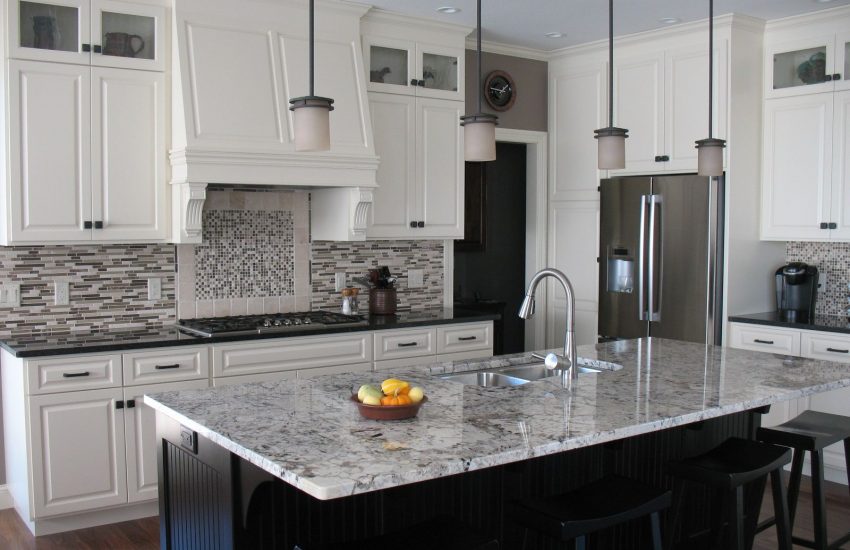
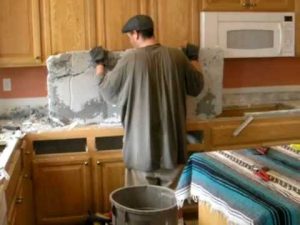 The old countertops and backsplash must be removed. Typically, the backsplash is installed directly over the drywall. When the old backsplash is removed, it destroys the drywall. Every kitchen backsplash has (or should have) a drywall backsplash regardless of what is installed over it. This drywall must be replaced prior to installing the new kitchen countertop. Installing a new backsplash over damaged drywall is a huge mistake. The new splash will likely crack, come loose, fall off, and allow water to enter – causing serious mold, mildew, and rot damage.
The old countertops and backsplash must be removed. Typically, the backsplash is installed directly over the drywall. When the old backsplash is removed, it destroys the drywall. Every kitchen backsplash has (or should have) a drywall backsplash regardless of what is installed over it. This drywall must be replaced prior to installing the new kitchen countertop. Installing a new backsplash over damaged drywall is a huge mistake. The new splash will likely crack, come loose, fall off, and allow water to enter – causing serious mold, mildew, and rot damage.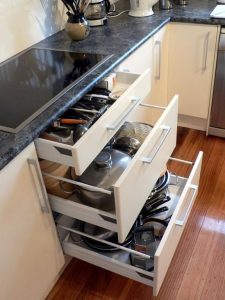 If you do not completely empty the contents of all drawers and cabinets, everything inside gets really dirty. All drawers and insides of cabinets will need a thorough cleaning after demolition and again after installation. Pay special attention to the drawer glides and door hinges. Dust and debris during demolition can destroy or seriously damaged these items.
If you do not completely empty the contents of all drawers and cabinets, everything inside gets really dirty. All drawers and insides of cabinets will need a thorough cleaning after demolition and again after installation. Pay special attention to the drawer glides and door hinges. Dust and debris during demolition can destroy or seriously damaged these items.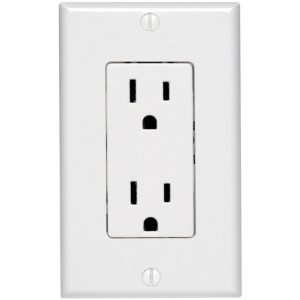 If your home is more than 3 years old, all of these items will require replacement. Why? The electrical and building codes have changed and tract housing electrical appliances typically have a 5 year or less safe and useful life. The term “appliances” refers to receptacles, switches, dimmers, smart plugs, and charging ports.
If your home is more than 3 years old, all of these items will require replacement. Why? The electrical and building codes have changed and tract housing electrical appliances typically have a 5 year or less safe and useful life. The term “appliances” refers to receptacles, switches, dimmers, smart plugs, and charging ports.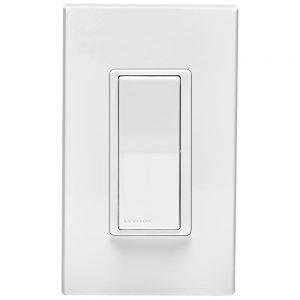 existing backsplash must be removed along with the electrical appliances in the backsplash. After installing the new backsplash, replace with new appliances. It makes little sense to reuse the old, worn out and unsafe appliances.
existing backsplash must be removed along with the electrical appliances in the backsplash. After installing the new backsplash, replace with new appliances. It makes little sense to reuse the old, worn out and unsafe appliances.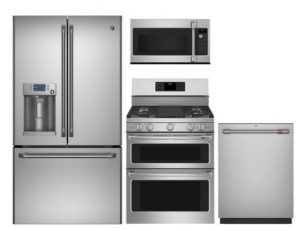 The microwave (or hood), dishwasher, range (or cooktop), and usually the refrigerator must be removed. When reinstalling the range or cooktop, install a new gas valve and connector. Also ensure the refrigerator gets a new ice maker water supply line. It might also need a new angle stop.
The microwave (or hood), dishwasher, range (or cooktop), and usually the refrigerator must be removed. When reinstalling the range or cooktop, install a new gas valve and connector. Also ensure the refrigerator gets a new ice maker water supply line. It might also need a new angle stop.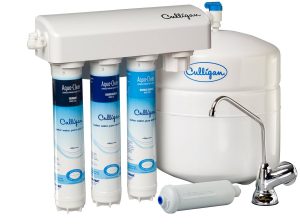 and replaced with new.
and replaced with new.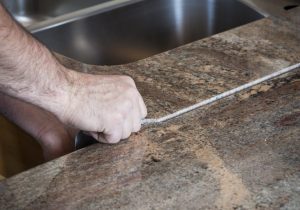 Overlays must have seams. Why? Large sections of ½ inch material will break during fabrication, transportation, and installation. Some seams may be more visible.
Overlays must have seams. Why? Large sections of ½ inch material will break during fabrication, transportation, and installation. Some seams may be more visible.